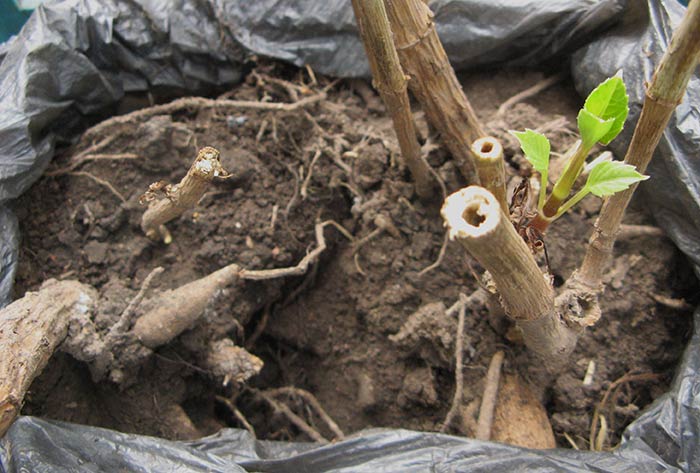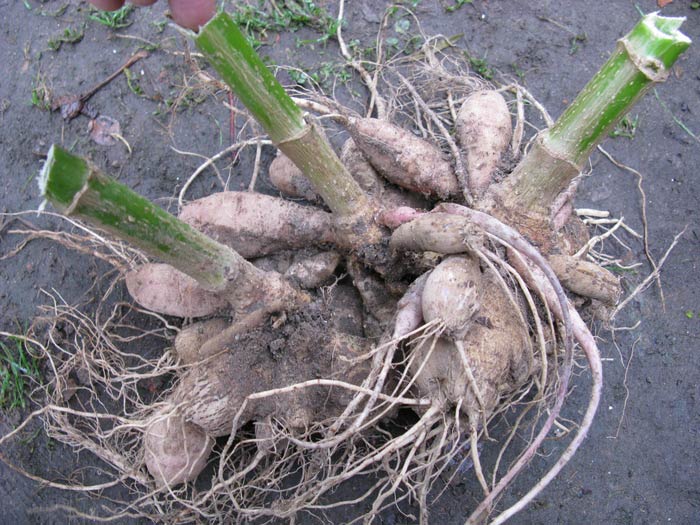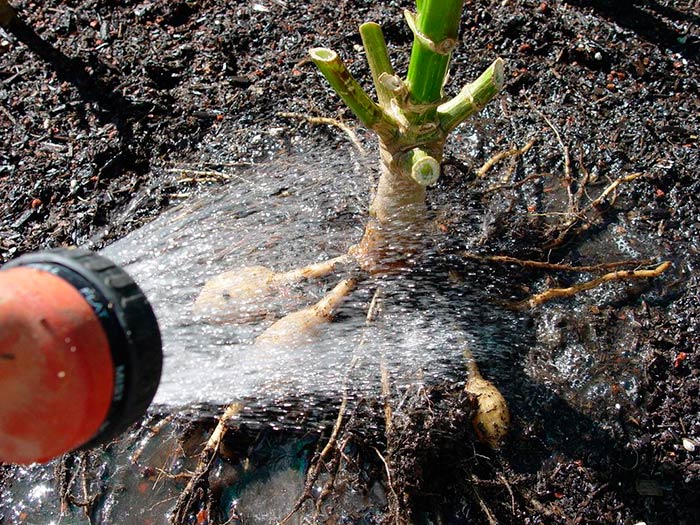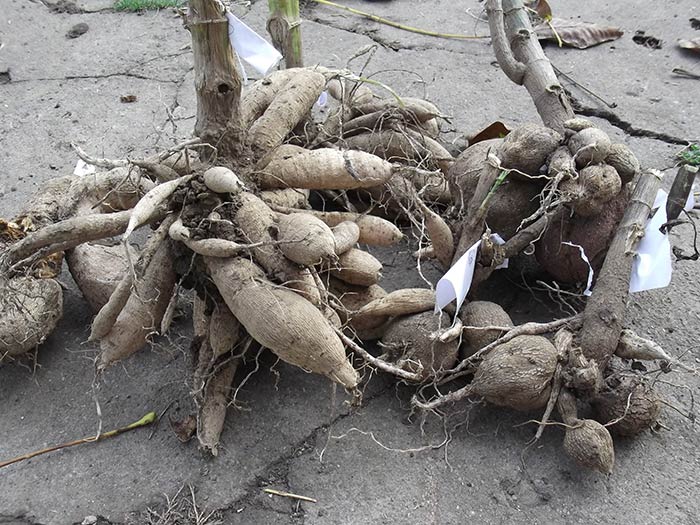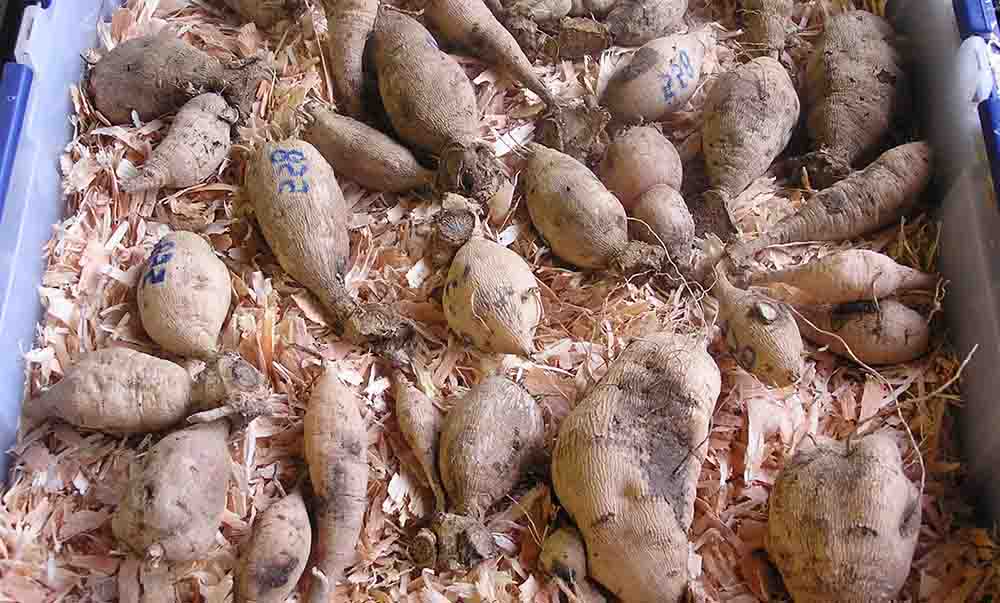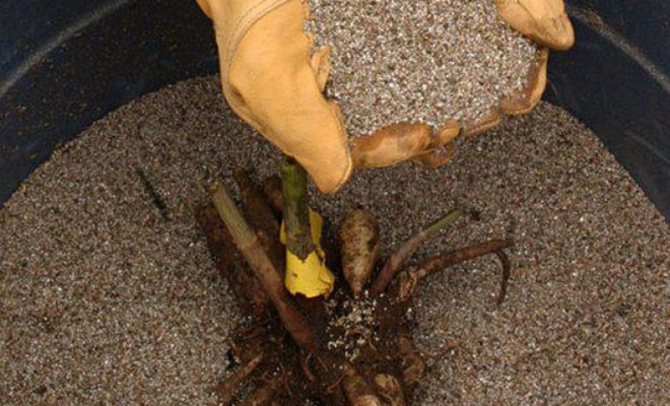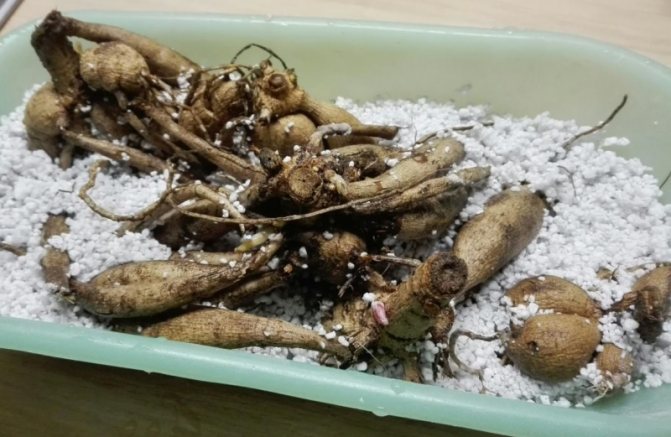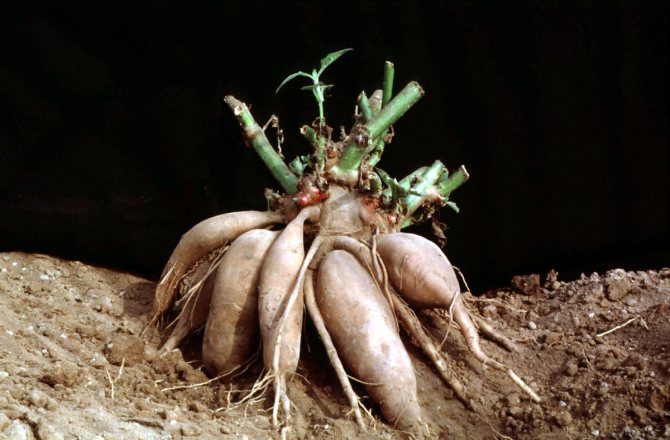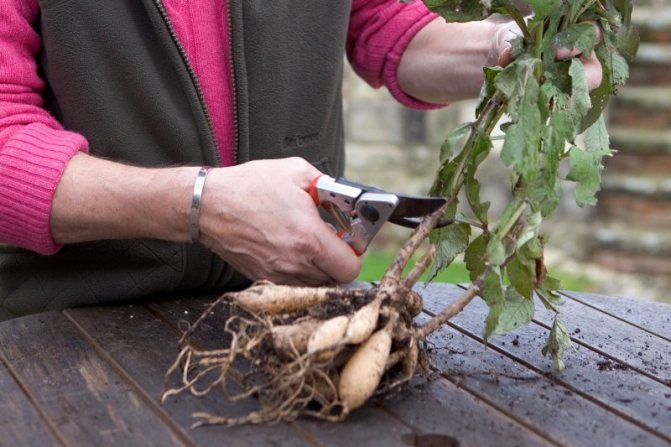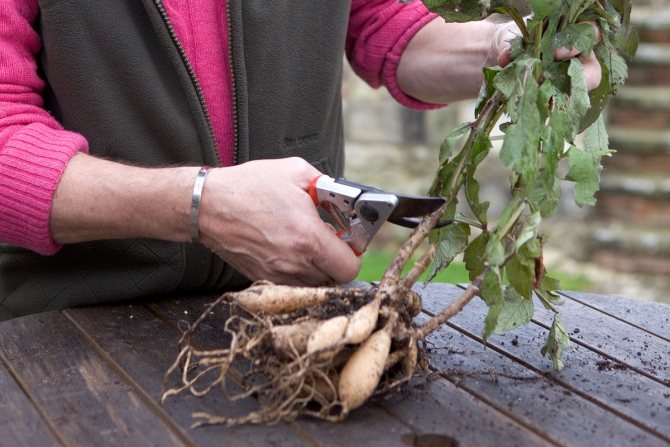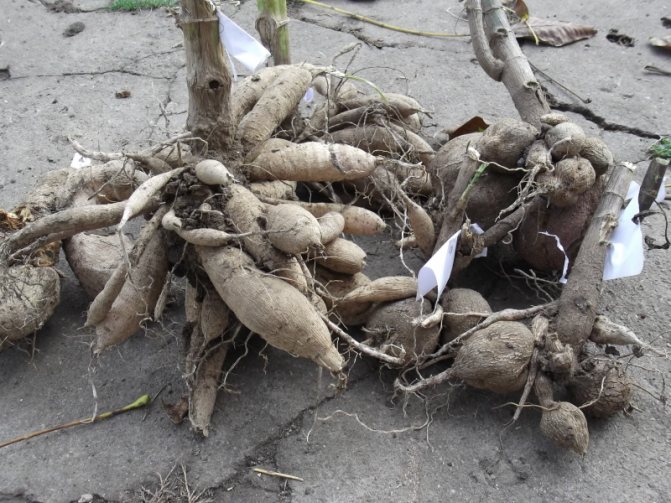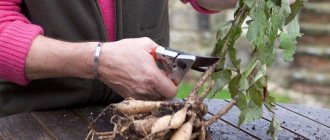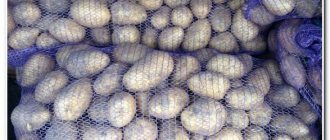The luxury and splendor of dahlias deserve the love of many gardeners and summer residents. Even the most modest site will be more exquisite if you plant dahlias on it. Therefore, it is not strange that in the arsenal of many summer residents and gardeners there are these flowering plants of various varieties.
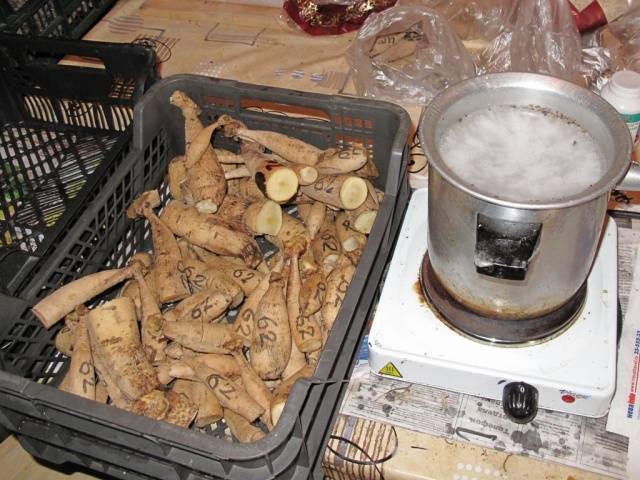
However, the joy of blooming dahlias will be short-lived if you do not provide the necessary conditions for winter storage of tubers in the house or apartment. This article will show you how to keep dahlias in your apartment until spring.
Features of the root system of dahlias
Dahlias have a rather complex root system. It consists of thickened roots, called storage tubers, and thin roots that supply nutrients to these very tubers. During the period of plant growth, tubers increase in volume, accumulating the necessary nutrients, and during winter storage they retain their viability. Each thickened tuber can live for 3-4 years. At the same time, less saturated tubers and thin roots die during the winter storage period.
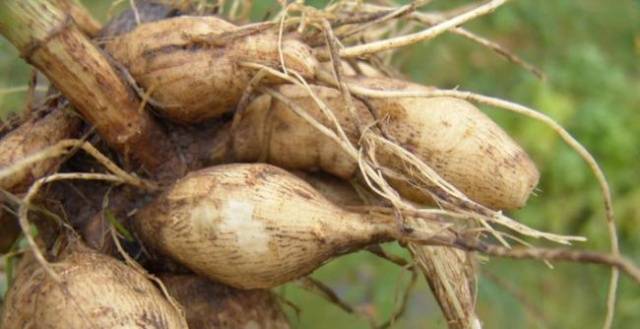

The roots of thermophilic dahlias are dug up for the winter and stored in favorable conditions until the onset of spring. However, it is necessary to understand that the bud of the growth of new shoots of the next season is not on the roots themselves, but in the lower part of the shoots of the last year, therefore, when cutting the bush in the fall, it is necessary to leave a small shoot of the stems.
Cellar preparation
The cellar is an ideal place for storing dahlia roots, as the temperature there corresponds to the conditions under which the roots will not germinate. Prepared rhizomes are laid out in boxes or on shelves, if space permits. Can be sprinkled with coniferous sawdust. It is better to lay out no more than two rows in boxes.
Preparing the cellar for the winter includes cleaning, airing, drying, disinfection and whitewashing. First of all, it is necessary to carry out sanitary cleaning: remove the remnants of last year's harvest, take out and dry the racks and boxes for storing planting material, take out the garbage.
It is necessary to ventilate the room in the summer or at the beginning of autumn, but no later than a month before the planting material is laid for storage. It is very important that the ceiling, basement walls and all equipment installed in it dry out during this period. This is especially true for wooden shelves and boxes, which can be a source of mold fungi and putrefactive microorganisms. These structures must be dried, cleaned, treated with an open flame of a blowtorch and replaced if necessary.
For disinfection, slaked or quicklime, potassium permanganate, copper sulfate are used. Walls and storage systems are treated with a strong solution of potassium permanganate (5 tablespoons per 1 liter of water). Then, with a solution of lime with the addition of 10% copper sulfate, the ceiling, walls, wooden racks and floors are whitewashed. After the basement has dried, sulfur checkers can be used for additional disinfection, which are used strictly according to the instructions.
The cellar must meet the following requirements:
- The air in the basement should be moderately humid. The optimum air humidity is 80%. Fluctuations in the humidity index from 60 to 100% are permissible. With this amount of moisture, dahlia tubers will not dry out and will not germinate prematurely.In excessively dry basements, in which the air humidity is below 60%, the planting material must be additionally moistened or a damp substrate prepared in advance must be used for storage.
- A room suitable for storage must be cool. The air temperature in the room must remain within the range of 1 ... 7 ° C throughout the winter. The temperature can rise up to 10 ° С, not higher. Exceeding this indicator can lead to premature emergence of sprouts and decay of rhizomes.
- The storage area for dahlias must be ventilated. The cellar should be able to do this regularly. Ventilation can be natural or forced. The stale air contributes to the spread of disease.
In order to create such conditions, it is necessary to insulate the basement. For this purpose, foam sheets are nailed onto the walls or the planting material is covered with hay or straw.
How to prepare tubers for storage
Various varieties of dahlias can delight you with the beauty of their flowers in spring, summer or autumn. However, the lush green mass of a plant with the arrival of the first frost always loses its elasticity and aesthetics. Leaves turn black, wilted. It was at this time, without waiting for severe frosts, to dig out the roots of dahlias for subsequent storage.
Important! In the central part of Russia, it is recommended to dig dahlias in late September - early October.
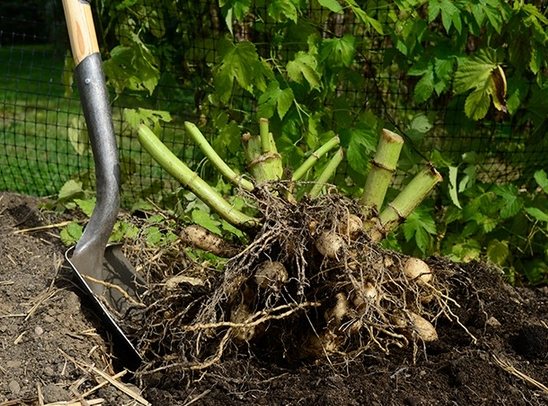

It is necessary to remove the roots of dahlias from the flower bed when the air temperature is above zero. You should first cut the plant bush, leaving 10-15 cm of shoots. The digging procedure must be carried out very carefully so as not to damage the fragile tubers of dahlias. To do this, first dig in the root neck, then the tubers themselves around the perimeter, at a distance of 20-30 cm from the neck.
In the fall, before storing, the dahlia root is divided. Next year, it will be possible to get a flowering bush from a part that consists of at least one tuber and a shoot with a growth bud. After dividing, the roots of dahlias are examined for damage, putrefactive spots. All suspicious areas on the surface of the tubers must be removed. Also remove the upper part of the left stem until the growth bud and thin roots.
Dahlia roots must be treated with a manganese solution or fungicide ("Maxim", "Fundazol") before storing them. For this, the tubers are washed with clean water and immersed, for example, in a 1% solution of potassium permanganate for 10 minutes. After processing, they are thoroughly dried. Recommended drying temperature is 150C, duration is from 2 to 10 hours.
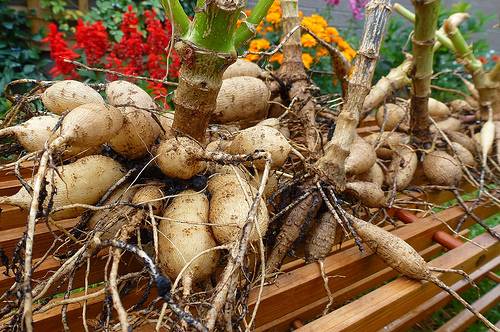

Important! During drying, it is recommended to turn the roots upside down with the cut shoots, so that all the moisture from the cavity of the stems is glass.
Dahlia care in autumn
Ripe root tubers from strong and healthy plants do not require special conditions for wintering. But there are rare varieties that painfully endure this period, and they need to provide the most optimal conditions for storage.
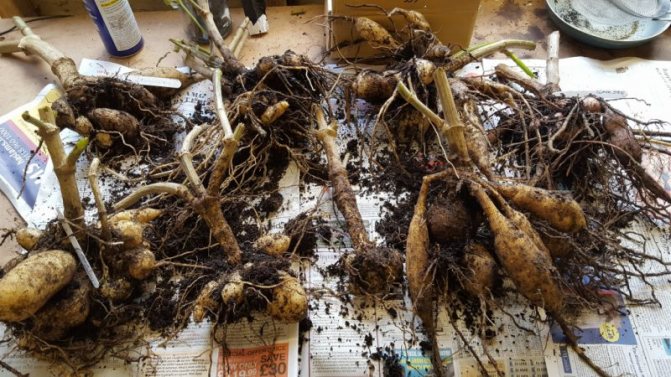

Storing dahlias requires a certain temperature and humidity.
- The temperature should vary between 2 and 7 ° C. At low temperatures, the planting material can freeze, and at high temperatures, it can rot or germinate prematurely.
- The optimum moisture content is 80 - 90%. If this figure is lower, the root tubers will shrink and will not be able to germinate.
Storage features largely depend on the level of humidity in a particular region. In areas with wet winters, planting material should not be stored in hermetically sealed bags. It is imperative to pierce 5 - 6 holes for gas exchange.
Since it is difficult to find a cold place in urban apartments during the heating season, it is better to store dahlias in hermetically sealed PET bags mixed with very dry perlite.
The most suitable place in an apartment for storing dahlias is a balcony. However, the tubers should be protected from frost.
If the rooms are humid and warm, only waxing will do. But such processing has not become widespread, since it is rather laborious. In addition, paraffin-treated delenki wake up much later. But in some cases, there is no other way out. Such root tubers are stored in bags with coniferous sawdust or dry peat.
The balcony is a good storage space. Root tubers are washed, dried, wrapped in thick paper and a bag, leaving it ajar for airing. If it's freezing outside, it is recommended to take the planting material into the room, and then take it back to the cool balcony.
The best place to store it is in a cool but damp cellar. If the room is dry, you need to take care of sufficient moisture in time. It is very difficult to keep the planting material in its original volume in a warm and damp basement, since such conditions provoke the appearance of various diseases.
The cellar is the perfect place to store dahlias in winter.
- It is convenient to store dahlias in the basement in tight plastic bags filled with large vermiculite. The main condition is a low storage temperature (maximum 7 ° C). The fact is that this material retains moisture and, when the temperature rises, can lead to rotting of the tubers.
- A good option is to use sand. Dahlias are stored well in it, but in spring they can give premature young shoots.
- Large softwood sawdust is also used for storage. Small sawdust is not suitable as it will draw too much moisture from the root tubers.
- Also, planting material is stored directly in the ground. To do this, take large wooden boxes, cover them with several layers of paper so that its edges not only cover the bottom, but also the sides. A thin layer of soil is poured at the bottom, the tubers are laid out at a sufficient distance from each other and again covered with soil, filling all the voids. This is done until the entire box is full. From above it is also covered with paper.
After digging, the delenki are kept in a solution of potassium permanganate for 12 hours, then dipped in a mash made of clay, water and any fungicide. Root tubers treated in this way are dried and removed to a cold dry cellar. With the onset of heat, the clay shell is broken by tapping and dahlias are immediately planted.
You can also save root tubers in the refrigerator. The dried planting material is kept in bags with sawdust, in which it is recommended to make holes for ventilation. The bags are additionally wrapped in paper and stored in the lower compartment of the refrigerator. If there are few root tubers, they are simply wrapped in paper and stored in the lower vegetable compartment.
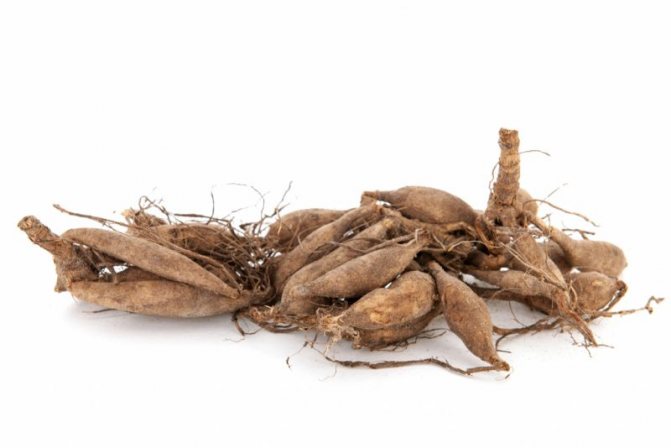

With any storage method, the planting material is checked approximately every 4 weeks.
Damaged tubers are thrown away immediately so that they do not infect healthy cuttings. In the spring, boxes or bags with dahlias are transferred to a warmer place so that the root tubers wake up faster.
Knowing how to properly store dahlias, you can admire these beautiful flowers in your garden from year to year, keeping your favorite varieties and not worrying about decorating the site every year.
The timing depends on the region. It will be correct to focus on the weather conditions and temperature specifically in the place. Dahlias bloom all autumn until frost comes. At this time, it is very desirable to huddle the bushes and close the basal growth buds so that they are not damaged by the low temperature. After the tops die from the cold, you need to have time to dig up the tubers for storage for a week, until the stem and rhizomes begin to rot.
Amateur flower growers often ask questions about how to store dahlias in winter, what conditions are necessary for tubers so that they will give new shoots next season.The best places to store the dug up bulbs are: well-ventilated basements, storage rooms, glazed and insulated balconies or a cellar. In these rooms it is easy to maintain the required temperature (3 ... 10 ° C) and moderate air humidity (60-70%). It is also necessary to ensure that direct sunlight does not fall on the planting material.
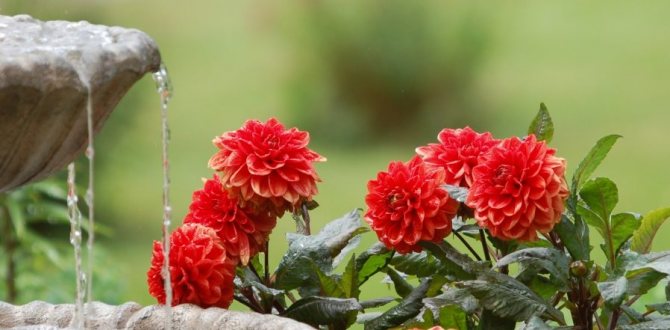

Professional florists outline several basic rules about when to dig up dahlias and how to store them:
- In order for the tubers to form and mature well, it is necessary to leave them in the ground for as long as possible.
- It is better to extract root crops at positive air temperatures and good weather, so that they can completely dry out in the sun.
- Before digging, it is necessary to cut off the stem, leaving 10-15 cm. After that, the bush must be dug from all sides and, using a shovel or a pitchfork, gently get it out of the ground. It is not recommended to drag the plant and shake off the roots too much, because this can damage the bulbs and stems.
In addition, there are the following guidelines on how to store dahlias after digging:
- Examine and check the excavated tubers carefully. Suitable for storage only healthy and undamaged by parasites and diseases root crops.
- If you find small putrefactive spots, cut them out with a special tool.
- After the stripping procedure, rinse the tubers with water and treat them with a potassium permanganate solution or other fungicide.
- Dry the bulbs well until the moisture has completely evaporated and leave indoors for a few days to harden the tubers.
Now let's figure out how to prepare dahlias for winter. In early September, the bushes need to be spud rather high (about 8-12 cm high). This will make them more resistant to wind and cover the base of the trunk, which means the tubers will grow strong. In general, the procedure can be carried out at the end of the summer.
Dahlias should be watered sparingly so that excess moisture does not lead to infection. Weak stems without buds, lower leaves, as well as dying flowers must be cut to speed up the formation of new buds.
To prevent diseases, treat washed dahlia tubers with a fungicide, for example, Fitosporin. Prepare the solution according to the instructions and soak the tubers in it for about an hour. Instead of fungicides, you can also use a pink solution of potassium permanganate. Soak the tubers in it for about 30 minutes.
Then label the tubers with the variety labels. If the variety is unknown, you can focus on the size of the bush, the shape or color of the flowers.
The next step in preparing dahlias for winter is drying the tubers. To do this, you need to choose a dark, cool place and put the bushes upside down so that the moisture accumulated in the stems flows out and the tubers do not rot later.
Dried dahlia tubers are tightly placed in plastic buckets or boxes and covered with dry sand or sawdust, leaving the tops of the stems with tags not sprinkled. To prevent sand from spilling out of the box, you can lay a bag of sugar on the bottom, and then lay out a layer of newspaper.
Gardeners differ slightly on how to preserve dahlia tubers: some use wet sand instead of dry. Everything here is individual, and if the tubers were dug up in dry weather, and then not soaked in a fungicide solution, then it is really better to moisten the sand or sawdust.
There are several more ways to store dahlia tubers in winter:
- dip the tubers in paraffin melted in a water bath, put them in boxes and store at a temperature of 12-14 ° C;
- spread the tubers in a box on a layer of peat, sprinkle them on top and store at a temperature of 3-5 ° C;
- fold the tubers into a cardboard box by transferring them with paper or wrapping them in cellophane bags.
Novice flower growers often ask themselves: is it necessary to dig dahlias for the winter, is there any way to avoid this troublesome procedure? Unfortunately, these plants are very afraid of the cold and will not survive until spring. But there is a way out. If storing dahlias in winter is problematic for you, grow them as annuals. Or you can dig up only the most beloved and expensive varieties, and plant the rest again in the spring. The decision is yours!
DETAILS: Care for strawberries after fruiting, pruning. Caring for remontant strawberries after fruiting
Storing dahlia tubers is not difficult, but responsible, because you need to look after the "wintering" plant: check the tubers, regulate the temperature regime. The dahlia will not remain in debt, but will delight you with its lush bright flowering!
A source
Autumn care for dahlias consists of:
- in harvesting fallen leaves;
- loosening the earth;
- proper watering.
If you paid due attention to a flower bed with dahlias during the summer season, autumn care will make the task easier. The first step is to remove fallen petals, leaves and other debris around the flowers. This is necessary in order to avoid the accumulation of pests that are preparing for wintering and infections. After that, carefully inspect your bushes.
Sick and dried flowers need to be dug up and burned. This will prevent the spread of infectious diseases to other flowers. When the dahlia is watered, it stores moisture at the bottom of the stem. This helps him survive the drought. To avoid decay of the root collar during storage, it is necessary to stop watering two weeks before digging up the roots.
In our climate, dahlias are annual flowers if the roots are not dug up and stored properly. Before you start digging, you need to wait for the cold weather, when the leaves on the stems freeze a little. This will harden the flowers and provide immunity.
Optimal storage conditions
In order to understand how to properly store dahlias in winter, you need to familiarize yourself with the conditions under which the roots will retain their vitality. So, for storing dahlias in winter, it is necessary to determine a place in which there will be a stable cool temperature within + 3 ... + 70C. The humidity level should not exceed 60-70%. In private houses, such conditions can be created in the cellar, basement. An insulated balcony can be adapted to store dahlia tubers in an apartment.
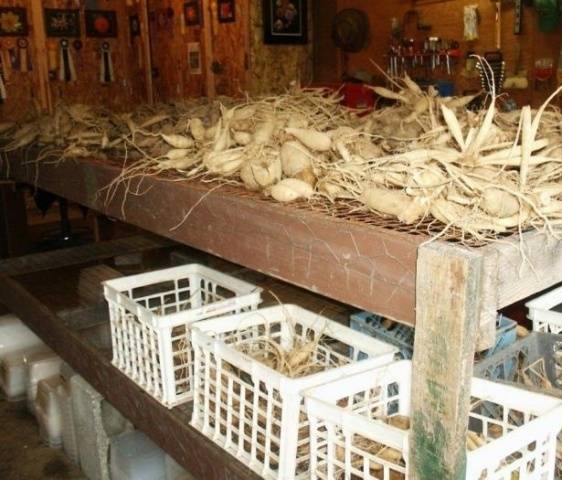

For the safety of dahlia tubers during winter storage, they are placed in bags, boxes or other containers. Additionally, the tubers are sprinkled with non-hygroscopic material, for example, sand. The most commonly used storage methods for dahlia roots are detailed below.
How to store dahlias after digging in the cellar. Using the cellar
This option is very common. There are several ways to effectively store dahlias in the cellar, for example, they use:
- sand;
- paraffin;
- polyethylene;
- perlite or vermiculite;
- clay.
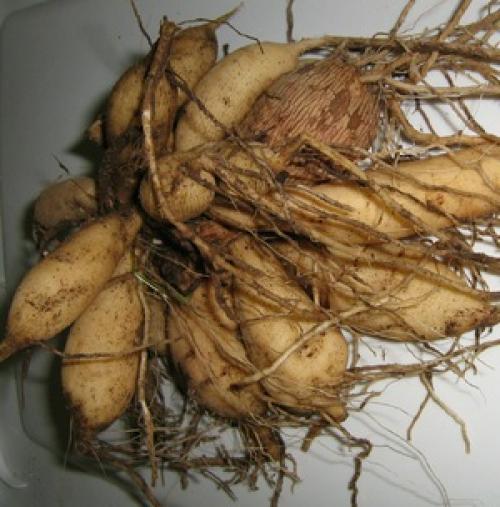

Tubers are poured with sand or sawdust in the same way as in the case of storage in basements. But to wrap each spine with polyethylene, then spreading them out into boxes, it is possible if a constant microclimate is maintained in the cellar, there is no temperature difference. The tubers are dried, disinfected well, wrapped neatly with cling film.
In dry cellars (and even basements), dahlia roots can be dipped in clay. The formed shell will be a kind of protection of the roots from drying out and damage by rodents. Fatty clay is mixed with water to the consistency of thick sour cream, well washed, disinfected, dried tubers are immersed in the finished solution.
Hold for a few seconds, take out, set aside to dry. Fungicidal agents are often added to the solution. When the clay dries, the tubers are collected in a container and placed in the cellar.In the spring, such a clay shell is easily removed by breaking or soaking it in water.
Professionals prefer to wax the rhizomes. Before the procedure, the tubers are washed, cleaned, disinfected, dried. The roots are placed in melted paraffin for a few seconds, pulled out. The substance cools instantly in air. The resulting shell qualitatively protects dahlias from rodents, premature germination, damage by viruses or pathogenic bacteria.
The most common paraffin is used, it is melted in a water bath to 60 degrees. After the first layer dries, for a denser shell, the rhizome can be dipped again. Tubers ready for storage are either sprinkled with sawdust, or folded into cellophane, stored in a cellar. Before a new planting, paraffin crusts are removed from the roots, gently rubbing them until cracking.
Dahlias can be stored in bags filled with perlite or vermiculite. Be sure to make holes for air circulation.
Storage methods
Storing dahlias after digging is not troublesome if the tubers were prepared correctly. Dry roots, disinfected with an antiseptic agent, are well stored in conditions with low temperature and humidity. Fluctuations in temperature can cause premature bud germination, which will lead to the death or deterioration of the quality of the planting material. It is also important to remember that only ripe tubers can be stored for storage. If you dig up the roots before the arrival of frost, then their keeping quality will be low.
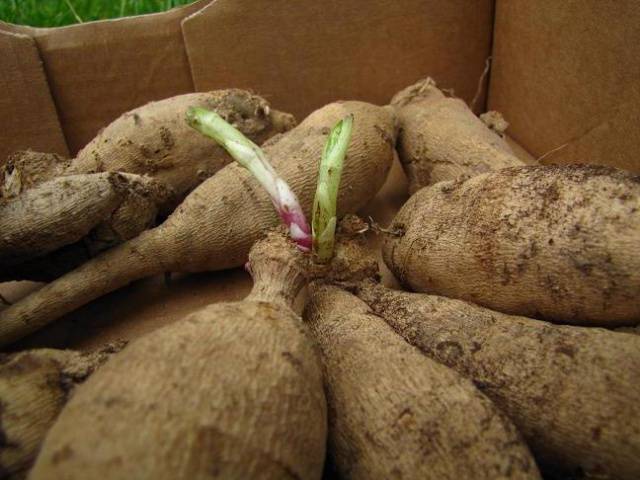

In private homes, it is easy to find a place to store dahlias. As a rule, you can find a secluded corner in the cellar with the required temperature and humidity. In this case, the roots can simply be put in a cardboard or wooden container, and with the arrival of spring, get the container out of the cellar and plant the roots in the ground. If there are no such conditions, then it is necessary to take care of the presence of a filler in the containers, which will protect the tubers from low temperatures and fluctuations in humidity. You can find out about using the most affordable methods for storing roots below.
In sand
Many country house owners prefer to store dahlia bulbs in the sand. This material does not absorb moisture or deplete tubers. For storing tubers, containers are filled with sand. It can be plastic or wooden boxes, buckets with a volume of 20 liters. Dahlia tubers are placed in the sand in one or more rows. The storage container is covered with burlap and lowered into the cellar or basement. In an apartment, it can be placed in a cold corridor or, for example, at a balcony door.
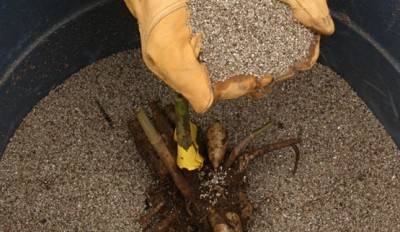

During storage, you can periodically check the condition of the roots. In this case, in no case should the sand be moistened, as this can lead to decay of the roots. The peculiarity of this storage method is the early awakening of the tubers. To prevent premature germination, it is necessary to reduce the storage temperature strictly to + 30C.
In peat
Peat can also be used for winter storage of dahlia tubers. To do this, sprinkle a layer of peat on the bottom of the box and spread the roots of dahlias on it. Another layer of peat is scattered over the tubers. Such boxes can only be stored in a cellar or basement, where there is no access to light and sudden temperature fluctuations.
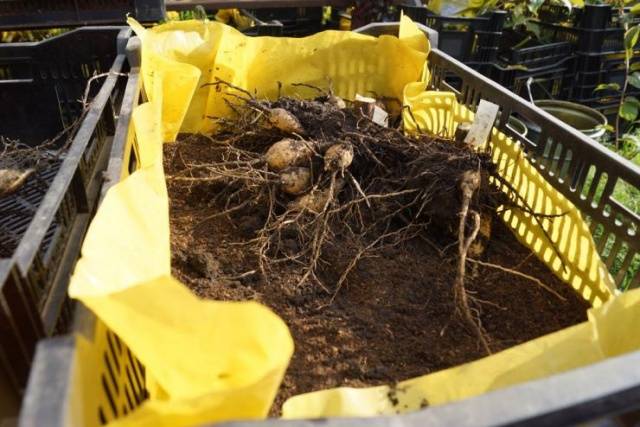

In sawdust
You can save dahlia tubers in sawdust until spring. The only requirement for such a filler is the size of the segments. It is better to use coniferous wood chips for storage. It will not absorb moisture from the environment and the roots themselves. Pour sawdust into a wooden or plastic container with air access. The use of sealed plastic bags to preserve the roots is not at all permissible, since the lack of ventilation will lead to their rotting.
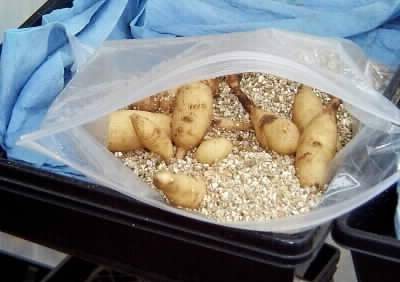

In paraffin
For some residents of apartment buildings, the issue of storing dahlias in room conditions is especially acute.For them, there is the most laborious, but effective way of storing the roots of dahlias, in which they use paraffin.
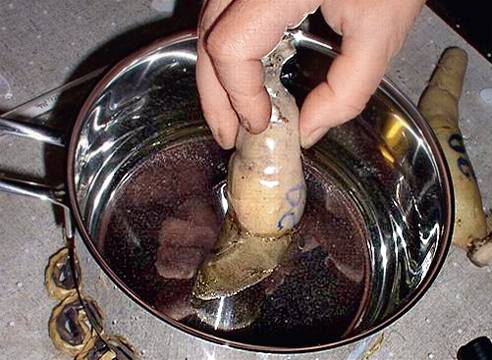

The main advantage of paraffin is its tightness. It prevents the roots from absorbing moisture and evaporating it. As a result of using such material, the tubers do not dry out and do not rot. Pathogenic fungi, bacteria and viruses do not develop under the layer of paraffin.
You can "pack" dahlia tubers in paraffin as follows:
- Candles or paraffin are ground into shavings (you can grate on a coarse grater) and then poured into a container, at the bottom of which there is a little water.
- The container with paraffin is placed in a water bath for melting. The result should be a layer of viscous liquid of 2-5 cm.
- It is necessary to immerse the roots in paraffin for just a few seconds. Taking them out of the container, you can see a paraffin film that will protect the tubers from external factors during winter storage.


Tubers in paraffin can be placed in boxes, buckets or bags, wrapped in foil. The peculiarity of this storage method is the premature germination of tubers. Therefore, it is recommended to use the method for early varieties.
An example of how to preserve dahlias in winter using paraffin is well described in the video:
Important! Only small, divided roots can be "dipped" into paraffin, otherwise a large amount of this substance will be needed.
Vermiculite for storing tubers
Vermiculite is a natural material that is not hygroscopic and can replace paraffin in its properties. For storing dahlia tubers, it is recommended to use coarse vermiculite. You can find it in the agricultural store. A layer of vermiculite is poured into an airtight container and tubers are laid on top of it, sprinkling with another layer on top. So, fill the entire container and close it with a film or a sealed lid.
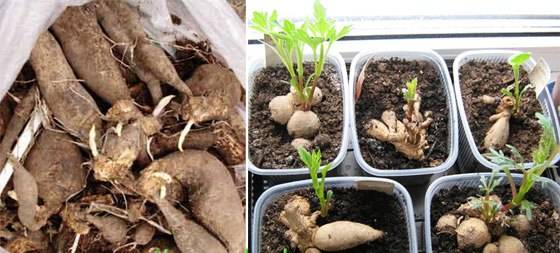

How to store dahlias in the refrigerator. How to store dahlias in winter


I store tubers in the basement because it is more optimal and easier, but I know several storage methods.
The main reason why it is not advisable to keep dahlias at home (in the room) is the drying out of the tubers. And in the refrigerator - decay, since in the refrigerator it's still a plus, it's cold and often humid. If you plan to store it in a room, then a dahlia is dug out after a strong freeze, when the green mass really froze and became, as it were, glass, the earth is not shaken off from the roots, that is, on the contrary, the largest lump is preserved, and fits right with a lump on the newspaper to dry the top layer land. Then, for example, a box is taken, into which either sawdust or moss is poured, or you can crumble foam plastic and the whole lump with earth is placed in this filler. In the spring they shake off the lump and divide the dahlia. If you plan to store it in the refrigerator, then waxing may be the safest option. To do this, we dig out the dahlia after a strong frost, when the greens turn glass, wash off all the earth, dry the tubers. If the tuber is very large, then we divide it into several parts. It is better to divide finely in the spring, to be sure that there will be kidneys on the division. Paraffin is bought at the pharmacy, melted in a saucepan and heated to a temperature of 70-80 degrees. Delenki are dipped into this paraffin. Then they put the waxed tubers, for example, in a cardboard shoe box. and put it in the refrigerator, you can also use the box for vegetables from the refrigerator itself.
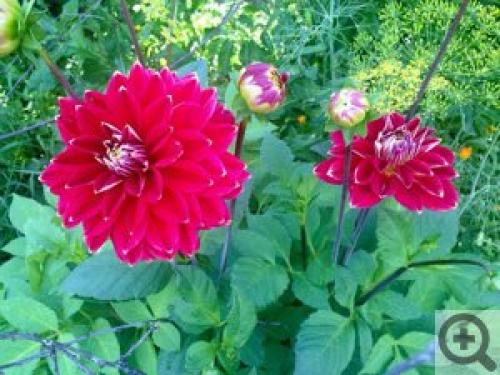

If there is a glazed balcony, then waxed tubers can be stored there, but they are very well insulated beforehand! For example, with polystyrene, wrap in a covering directly in a very multi-layer, in something else that comes up. In the spring, you do not need to remove the paraffin, just get the dahlias in the heat and the sprouts will hatch through the paraffin. I can tell you about my experience of storage in the basement. I have a special basin. I put new sawdust into it every year.They can be taken from any sawmill. I keep the sawdust for some time in a warm room, right in the basin and stir it to dry it. And sometimes they come across dry immediately. I dig up dahlias after freezing, wash them off the ground, divide, if a large root, and put them in a basin. The main thing is not to come into contact with each other. And without closing the basin with anything I take it to the basement. In winter, I used to check for rot, but in recent years I stopped doing this, since they feel completely normal in sawdust - they are not wet and do not dry. Also in the same basin with sawdust, to the dahlias, I put all the tubers and bulbs that I dig up for the winter - gladioli, calla lilies. Every year everything winters well. At one time we tried to store it in a basin and in the sand, but it rotted. Apparently the dampness of the basement was absorbed. It would be very great if, as expected, before laying in the basement, soak the tubers in maxim for 30 minutes and then dry them after soaking. That is, wash it off the ground and immediately soak it in maxim. if there are invisible pests on the tubers and bulbs, then they will die and the chances of overwintering will increase many times over. I myself sometimes soak, sometimes not. I do not soak if I see that the tuber is just perfect. If the tuber was cut during digging, then cover the incision either with ash, or brilliant green, even iodine will do, or with garden pitch, if it is at hand (with which the tree cuts are covered). One more nuance. In some varieties of dahlias, the tuber is thin, such a feature of the variety. Here they are most susceptible to drying out. And even in the basement, where it is optimal for them, they can dry out. It is best to bathe such dahlias in paraffin, so as not to get upset in the spring.
Tips and tricks from specialists
In no case should you pull the dahlia by the stem. In order not to damage the dahlia root, the bush must be dug with a pitchfork on four sides, departing from the stem 20-30 cm, thus cutting off the long roots and digging out only the tubers. Then press the forks to raise them above the ground and set them aside.
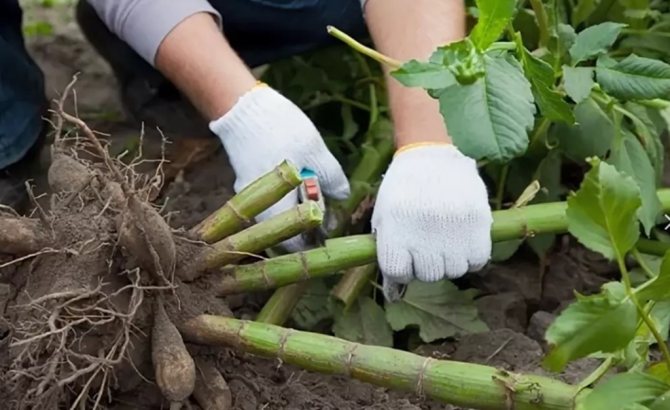

The best places for storing tubers are a basement, a garage, an insulated loggia.
IMPORTANT: The necks of the tubers are very fragile, in order for them to become stronger, leave the dug root in the flower bed to dry. Then you can remove soil from them, separate and proceed to disinfection.
It is more convenient to process and store dahlias by disassembling them into divisions, that is, into individual tubers. It is better to divide the root in the fall, since it will harden significantly during the wintering period. Examine the tuber neck carefully, find the eyes of future shoots and separate it from the rest. If the eyes are poorly visible, then in this case you will have to wait for spring to divide the root.
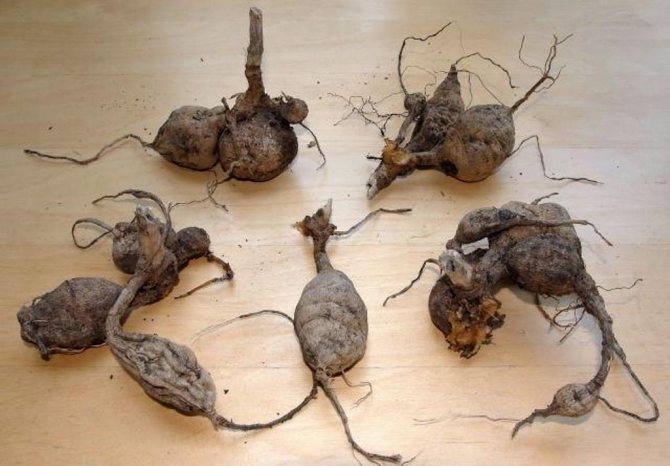

Tubers are not just dug out of the ground - they also need to be properly prepared for storage.
When buds appear on the necks of the tubers, it will not be difficult to determine the place of division. Small parts of the root can be stored without dividing. Inspect the resulting divisions, if the inside of the neck is brown or has rusty spots, cut this part off completely. If the tuber neck is discolored, then this is also a sign of disease. Dahlia does not hibernate with such defeats.
NOTE! If you break off a tuber without a neck, then it will not germinate.
The main dahlia tuber should not be discarded. In the spring it can be used for cuttings.
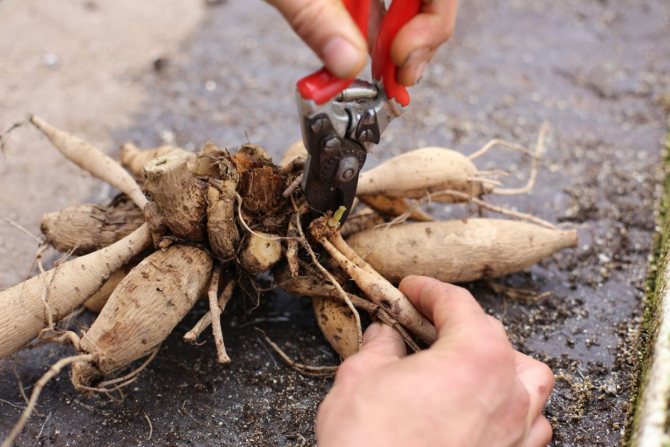

If there is no way to store dahlias in the country, summer residents will have to transfer the tubers to the apartment, creating a suitable atmosphere there.
Before planting large tubers, cut and dry the slices, and small and without preparation will give a large number of suction roots, which contributes to the rapid growth of the flower.
During wintering, dahlias can be affected by insects or rodents. When thrips, ticks, wireworms and other pests appear, the tubers must be treated with one of the insecticides. When handling them, personal protective equipment should be used to prevent contact of the chemical with skin and respiratory tract.
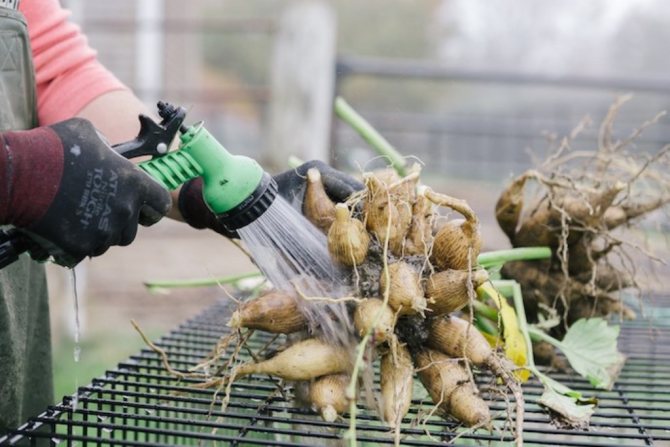

After treating the roots with fungicides, they are brought into a cool, ventilated room for a week for further drying.
Since you will be applying the drug indoors, using it without gloves and a respirator can lead to poisoning. In winter, rats or mice may appear in the cellar or basement. They are capable of partially or completely destroying your planting material. Use traps or poisons to fight them.
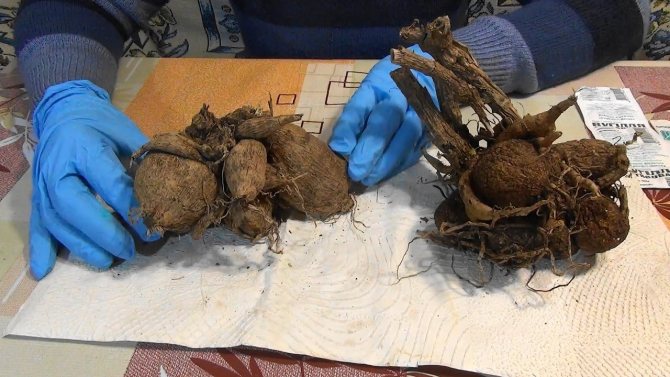

If breeding of the bush is planned next year, the rhizome is divided into separate nodules.
INTERESTING FACT! Paul Callahan is a famous gardener who revived the undeservedly forgotten dahlia in the 80s of the 20th century. Dahlia gardens were laid out on the territory of Coulf's domain. Until now, members of the dahlia lovers society continue to care for flowers, which are the pride and main attraction of those places.
Follow the tips and instructions in this article and you'll be sure to save your dahlias until next season.
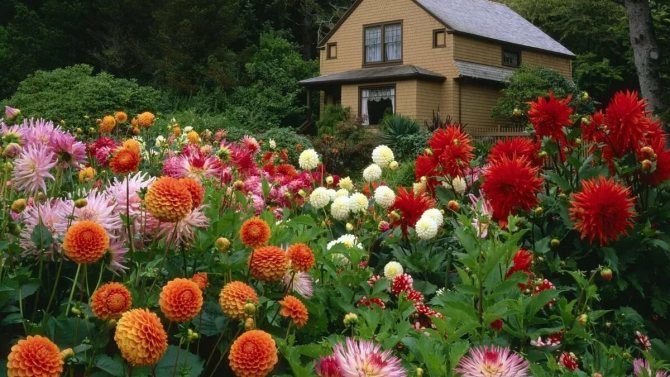

It is recommended to prepare nodules from each bush separately for winter storage, marking them in the process.

